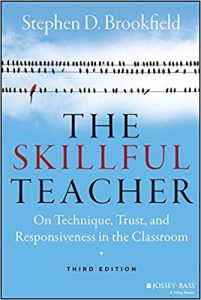Regardless of how egalitarian an instructor tries to practice, the reality is that they have “power” over course curriculum, classroom activities and evaluation criteria. It is important to acknowledge and utilize this position of authority in a responsible way rather than seemly ignore it and then later utilize it in a punitive way. In Chapter 18: Exercising Teacher Power Responsibly in The Skillful Teacher, Brookfield (2015) addresses the responsible use of power in the classroom. Interestingly, he indicates that while the instructor power includes positional title, by virtue of training, subject competence and personality, learners also have and can exercise power. Ironically, learners can leave teachers feeling powerless by simply refusing to ask or answer questions.
 Some of the characteristics of justifiable power and authority which students have identified include: transparency, responsiveness and being consistently fair. As a nurse who worked in hospital management prior to transitioning to nursing education, I was “taught” the importance of these characteristics by my more senior staff, who had no difficulty calling me out any time they perceived inconsistencies in transparency, responsiveness or fairness. This has served me well as a guide as I transitioned from nursing management to nursing education.
Some of the characteristics of justifiable power and authority which students have identified include: transparency, responsiveness and being consistently fair. As a nurse who worked in hospital management prior to transitioning to nursing education, I was “taught” the importance of these characteristics by my more senior staff, who had no difficulty calling me out any time they perceived inconsistencies in transparency, responsiveness or fairness. This has served me well as a guide as I transitioned from nursing management to nursing education.
One of the identified challenges that teachers can face is student disinterest in a particular topic that a teacher deems important. This can pose a challenge, however a key strategy is to be open and honest with students, and provide them with rationale for your choices, while at the same time pressing forward. Hopefully this honesty and transparency will help students be willing to engage with you.
From: Brookfield (2015). The skillful teacher: On technique, trust, and responsiveness in the classroom. San Francisco: Jossey-Bass.
 mptions are that:
mptions are that: